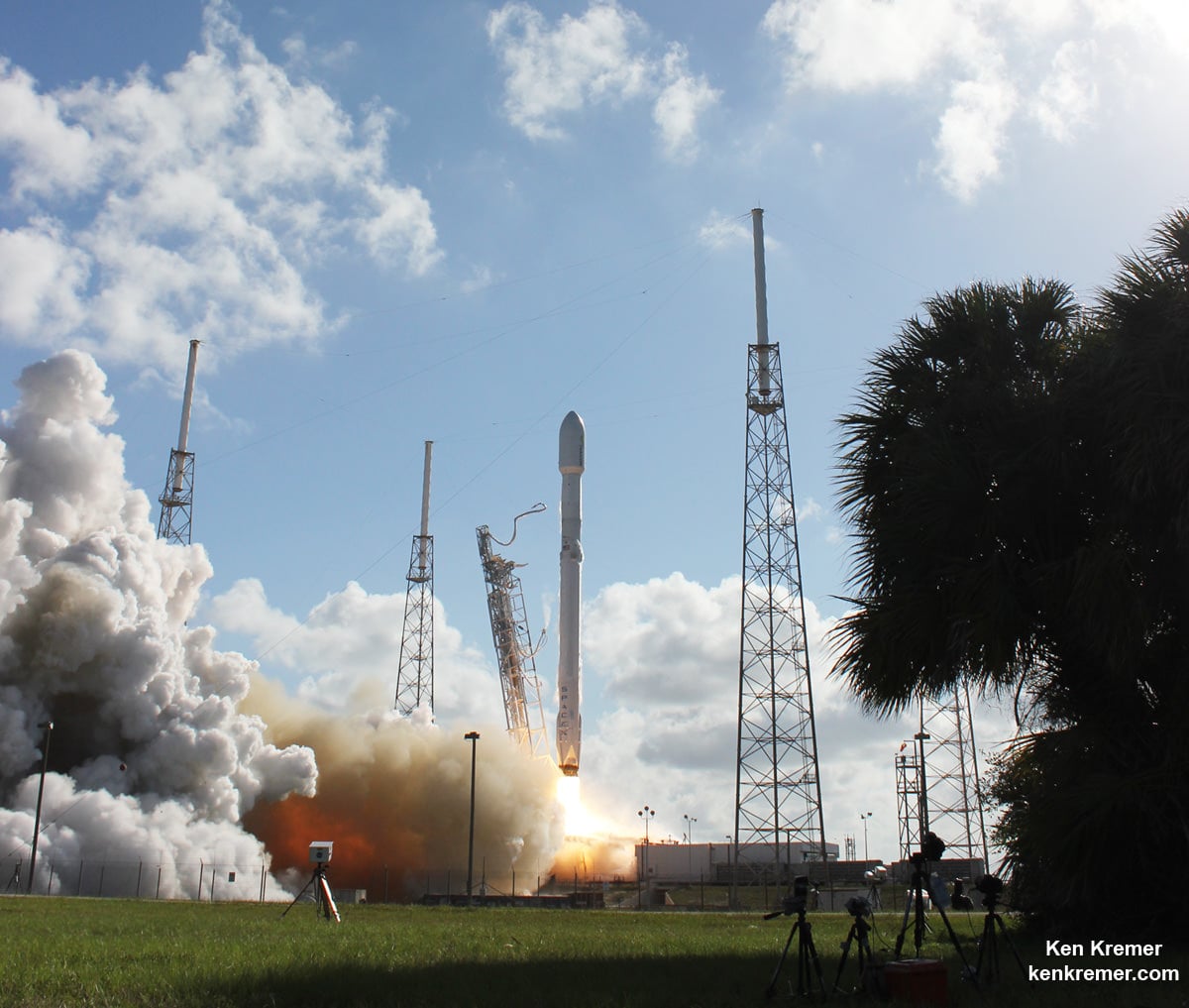[caption id="attachment_129179" align="aligncenter" width="1200"]
Upgraded SpaceX Falcon 9 blasts off with Thaicom-8 communications satellite on May 27, 2016 from Space Launch Complex 40 at Cape Canaveral Air Force Station, FL. 1st stage booster landed safely at sea minutes later. Credit: Ken Kremer/kenkremer.com[/caption]
CAPE CANAVERAL AIR FORCE STATION, FL. - Atop a billowing plume of fire and smoke
a SpaceX Falcon 9
rocket soared to space this afternoon, Friday, May 27, as the crackling thunder of the engines roared across the Florida space coast and the company scored a stunning
double headed launch and landing
success.
The 229 foot-tall (70 meter) Falcon 9 successfully delivered a 7000 pound commercial Thai telecommunications satellite to a Geostationary Transfer Orbit (GTO) and the first stage booster successfully soft landed on a platform at sea some nine minutes later.
Thus SpaceX is now an unfathomable 3 for 3 in the last three first stage landing attempts - both at sea and on land.
Even more remarkable is the string of two straight successes in landings via the high energy reentries as a consequence of launching the commercial payloads to GTO.
The Falcons screams were the loudest and most thrilling I've ever heard from a SpaceX launch as the two stage rocket lifted off on time at 5:39 p.m. EDT from Space Launch Complex-40 at Cape Canaveral Air Force Station, FL.
"Satellite deployed to 91,000 km apogee," tweeted SpaceX CEO and founder Elon Musk.
"All looks good."
[caption id="attachment_129181" align="aligncenter" width="1100"]
Upgraded SpaceX Falcon 9 blasts off with Thaicom-8 communications satellite on May 27, 2016 from Space Launch Complex 40 at Cape Canaveral Air Force Station, FL. 1st stage booster landed safely at sea minutes later. Credit: Ken Kremer/kenkremer.com[/caption]
The spectacular looking launch into mostly sunny Florida skies followed a days delay forced by a technical glitch in the second stage.
SpaceX engineers had to lower the Falcon 9 to the horizontal position and hurriedly fix the second engine actuator that gave concerning readings during Thursday's original launch attempt and scrubbed the liftoff - and do so in time to safely carry out a launch attempt late this afternoon.
Hundreds of millions of dollars were at stake on this commercial flight slated to deliver the Thaicom-8 comsat to a Geostationary Transfer Orbit (GTO) for Thaicom PLC, a leading satellite operator in Asia.
The first and second stages separated as planned about 2 minutes and 39 seconds after liftoff.
The nosecone, or payload fairing deployed into two halves at about T plus 3 minutes and 37 seconds.
[caption id="attachment_129163" align="aligncenter" width="900"]
Up close view of payload fairing of SpaceX Falcon 9 rocket delivering Thaicom-8 communications satellite on May 27, 2016 from Space Launch Complex 40 at Cape Canaveral Air Force Station, FL. Credit: Ken Kremer/kenkremer.com[/caption]
The second stage with Thaicom-8 continued to orbit. A pair of burns carried Thaicom-8 to orbit and the satellite was deployed at T plus 31 minutes and 56 seconds.
The rocket arced over as it accelerated eastwards towards Africa.
The nine first stage Marlin 1D engines on the 229 foot tall Falcon 9 rocket generate approximately 1.5 million pounds of thrust.
Thaicom-8 was built by aerospace competitor Orbital ATK, based in Dulles, VA. It will support Thailand's growing broadcast industry and will provide broadcast and data services to customers in South Asia, Southeast Asia and Africa.
[caption id="attachment_129117" align="aligncenter" width="1023"]
Thaicom-8 communications satellite built by Orbital ATK will launch on SpaceX Falcon 9 on May 26, 2016. The satellite has delivered to the launch site in Cape Canaveral, Florida in late April 2016. Credit: Orbital ATK[/caption]
The Falcon 9 launch is the 5th this year for SpaceX.
Meanwhile, the first stage began a series of propulsive burns of a Merlin 1 D engine to target a drone ship platform at sea.
SpaceX said the barge was positioned some 620 km off the Florida coast in the Atlantic Ocean.
After the primary goal of delivering Thaicom-8 to GTO, the secondary test objective of SpaceX was to land the Falcon 9 rockets first stage on the ocean going barge.
The Autonomous Spaceport Drone Ship (ASDS) platform is named "Of Course I Still Love You."
[caption id="attachment_129182" align="aligncenter" width="800"]
SpaceX Falcon 9 aloft with Thaicom-8 communications satellite after afternoon liftoff from Space Launch Complex 40 at Cape Canaveral Air Force Station, FL on May 27, 2016. Credit: Ken Kremer/kenkremer.com[/caption]
However with this mission's GTO destination, the first stage was subject to extreme velocities and re-entry heating and a successful landing would be difficult.
Altogether, SpaceX has now recovered 4 first stage boosters - 3 by sea and 1 by land.
The quartet of landings count as stunning successes towards SpaceX founder and CEO Elon Musk's vision of rocket reusability and radically slashing the cost of sending rockets to space by recovering the boosters and eventually reflying them with new payloads from paying customers.
SpaceX hopes to cut launch costs by one third initially, and much much more down the road.
Watch for Ken's on site reports direct from Cape Canaveral and the SpaceX launch pad.
[caption id="attachment_129183" align="aligncenter" width="1200"]
SpaceX Falcon 9 arcs over eastwards with Thaicom-8 communications satellite after liftoff from Space Launch Complex 40 at Cape Canaveral Air Force Station, FL on May 27, 2016. Credit: Ken Kremer/kenkremer.com
[/caption] Stay tuned here for
Ken's
continuing Earth and planetary science and human spaceflight news.
Ken Kremer
[caption id="attachment_129185" align="aligncenter" width="600"]
THAICOM 8 spacecraft as seen during deployment into a nominal supersynch transfer orbit. Credit: SpaceX[/caption]
………….
Learn more about SpaceX Falcon 9 rocket, ULA Atlas rocket, Orbital ATK Cygnus, ISS, Boeing, Space Taxis, Mars rovers, Orion, SLS, Antares, NASA missions and more at Ken's upcoming outreach events:
May 28: "SpaceX, ULA, SLS, Orion, Commercial crew, Curiosity explores Mars, Pluto and more," Kennedy Space Center Quality Inn, Titusville, FL, afternoon/evening
[caption id="attachment_129186" align="aligncenter" width="600"]
Falcon 9 first stage landed on the droneship in the Atlantic Ocean after launch of Thaicom-8 on May 27, 2016. Credit: SpaceX[/caption]
 Universe Today
Universe Today
